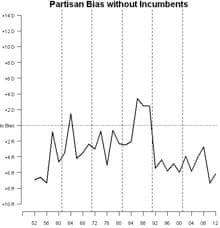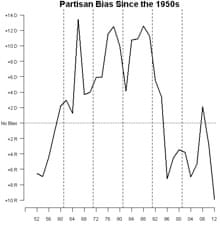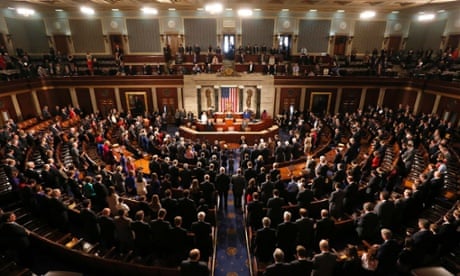You ever hear a point of view that is so infuriating that you want stick your head out the window and yell? I go bananas when I hear an opinion that goes against well-established political science literature.
That happened this past weekend when respected television journalist Tom Brokaw said the House of Representatives is becoming increasingly polarized because of gerrymandering.
Don't get me wrong, I love Brokaw. It just so happens that he is wrong, and posts about the effect of gerrymandering on redistricting have been written over and over again in past months.
It could be that Brokaw doesn't quite understand what gerrymandering is. For those who don't, gerrymandering is the manipulation in the drawing of House districts to ensure a desired result. Brokaw's assumption is that politics is becoming more polarized as the result of gerrymandering in districts in which Democrats and Republicans are increasingly safe from worrying about a competitive challenger from the other party.
While it is true that House districts are increasingly "safe", this is the case even when controlling for redistricting. Last week, Nate Silver noted that there was an 8% increase in polarization independent of any effects of redistricting in 2012.
Much of this change is because states themselves are becoming more polarized. As I pointed out in my last article, the number of swing states in presidential elections is at an all-time low. The number of Democratic and Republican senators from states that lean Democratic and Republican on the presidential level respectively is way up. Partially as a result, there is an increasingly large gap in ideology between Democratic and Republican senators, which has tracked with the ideological gap in the House. So unless, we are, all of a sudden, redistricting state lines, then gerrymandering can't possibly be the cause of what we're seeing at the state level.
Part of what's going on in the House is that there is a natural inclination for Democrats to crowd into cities and Republicans to spread themselves out in suburban and rural areas. In New York City alone, there were five Democratic members of Congress re-elected with at least 90% of the vote. Jowei Chen and Jonathan Rodden ran redistricting simulations on the precinct level and still ran up against a natural bias that prevents Democrats being able to win more seats because of their urban concentrations. There really isn't any way to fix this issue – at least, not by redistricting.
Nolan McCarty, Keith Poole, and Howard Rosenthal computerized redistricting with the aim of creating "fair" non-gerrymandered districts. Even when they tried their best to have "many heterogeneous and competitive districts", the predicted level of polarization didn't differ much from what we have today. Keep in mind, of course, that this sort of redistricting also would reduce the number of minority members of Congress because it neglects the Voting Rights Act. I get the feeling that wouldn't be particularly popular.
We see this in Nicholas Goedert examination of the 2012 House results, too. Goedert looked at seats in which redistricting was controlled by Democrats, by Republicans, by bipartisan committees or by courts. Controlling for past-vote-to-seat curves, Goedert determined that when redistricting was nonpartisan or bipartisan, Democrats underperformed by an average of 7pt (that is, they only take 50% of seats when projected to get 57%).
This is absolutely key. Fair redistricting just doesn't have the impact you might think. Once we control for incumbency, as Eric McGhee does in the chart below, Democrats are at an inherent disadvantage that dates back to the 1950s – long before Republicans controlled a majority of the redistricting processes.

Speaking of the effect of incumbency (that is, incumbents run ahead of what the national house vote would indicate), you'll notice that it had a major effect the last few cycles. According to Think Progress, Democrats would have needed to have taken the national house vote by 7pt in 2012 to have won a majority of seats. The author, Ian Millhiser, blames this on gerrymandering.
Here's the problem. After the 2008 House election, which was fought under Republican-gerrymandered district lines of 2000 district lines seats, the Democrats, who were already the majority party in the House, actually controlled more seats than they should have – given a 10.5pt victory in the national House vote.

The vote-to-seat curve will likely bounce closer to equal when incumbent Republicans sense a wave and retire, as they did in 2008.
None of this is to say that partisan gerrymandering doesn't have any effect. Sam Wang believes Republicans are far more likely to gain seats than Democrats when they control the redistricting process. Goedert's analysis, which includes more states, agrees, but also shows that Democrats are likely to take more seats than they should if they gerrymander as well. Goedert demonstrates that Republicans gain more seats by about 18 percentage points in a state when they control redistricting. Democrats pick up only about 9pt more when they draw the lines. This difference is, in my opinion, likely a reflection of the natural disadvantage Democrats have in redistricting – as seen in the 7pt Democratic underperformance in the non- and bipartisan states.
Overall, even if all the states redid their lines under "fair" rules, and given the Democratic win by 1pt in the 2012 House popular vote, Republicans would likely still maintain about 225 seats in the new Congress.
To correct for this imbalance, you would have to gerrymander. That is, you would have to manipulate the drawing of House districts to ensure the desired result. You'd need to have weird lines that snake from neighborhood to neighborhood, ignoring geographical integrity. That's not only against the law in many states, it would also make congressmen and women unrepresentative of at least part of their long, winding districts.
Yet, this doesn't tell the entire story. All of this analysis is based on the idea that the partisanship of the district causes the partisanship of the legislator. However, the difference in ideology between Republicans and Democrats in competitive districts and Republicans and Democrats in uncompetitive districts respectively is actually relatively small.
The real difference is how Republicans and Democrats differ ideologically in similarly partisan districts. McCarty and Boris Shor found that even in 50/50 districts (that is, those split evenly between Democrats and Republicans), the ideological divergence between Democratic and Republican representatives has climbed much higher in the past 40 years. So, even if you were to gerrymander evenly competitive districts, you would not likely see everyone coming together in Congress.
Anyway you put it, Democrats and Republican legislators have greater ideological differences than ever. Gerrymandering probably doesn't help, yet it's not the major cause of the problem. Natural geographic divisions on the state and local level between Democrats and Republicans are a big cause in this growing polarization. Both of these, though, fail to account for the fact that even when controlling for district partisanship, there are increasing ideological differences between Democrats and Republicans in Congress.
